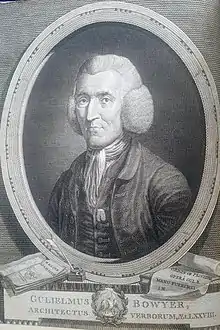William Bowyer (printer)
William Bowyer (/ˈboʊjər/; 19 December 1699 – 13 November 1777) was an English printer known as "the learned printer.
William Bowyer (printer) | |
|---|---|
 An engraving of William Bowyer from John Nichols' Anecdotes of William Bowyer | |
| Born | 19 December 1699 |
| Died | 13 November 1777 |
| Nationality | British |
| Occupation | Printer and publisher |
| Years active | 1722-1777 |
Born in London, he was educated at St John's College, Cambridge,[1] and in 1722 became a partner in his father's business. In 1729 he was appointed printer of the votes of the British House of Commons, and in 1736 printer to the Society of Antiquaries, of which he was elected a fellow in 1737.[2] He was also appointed printer to the Society for the Encouragement of Learning. On the death of his father in 1737 he became the sole owner of the Bowyer press.
In 1759 he took as apprentice John Nichols, who was to be his successor and biographer.[3] Bowyer was also a close collaborator with the prominent London bookseller Andrew Millar.[4]
In 1761 Bowyer became printer to the Royal Society, and in 1767 printer of the rolls of the House of Lords and the journals of the House of Commons.[2] Also in 1767 he moved from Whitefriars to a larger house in Red Lion Passage, Fleet Street. He died leaving unfinished a number of large works and among them the reprint of Domesday Book.[2]
He wrote a great many tracts and pamphlets, edited, arranged and published a host of books, but perhaps his principal work was an edition of the New Testament in Greek, with notes. He also edited the Greek-Latin Lexicon of Schrevelius. His generous bequests in favour of indigent printers are administered by the Stationers' Company, of which he became a liveryman in 1738, and in whose hall is his portrait bust and a painting of his father. He was known as "the learned printer."[2]
.jpg.webp)
Bowyer was buried in Leyton parish church, where he has a monument.[5]
Notes
- "William Bowyer (BWR716W)". A Cambridge Alumni Database. University of Cambridge.
-
 One or more of the preceding sentences incorporates text from a publication now in the public domain: Chisholm, Hugh, ed. (1911). "Bowyer, William s.v. William Bowyer (1699–1777)". Encyclopædia Britannica. 4 (11th ed.). Cambridge University Press. p. 349.
One or more of the preceding sentences incorporates text from a publication now in the public domain: Chisholm, Hugh, ed. (1911). "Bowyer, William s.v. William Bowyer (1699–1777)". Encyclopædia Britannica. 4 (11th ed.). Cambridge University Press. p. 349. - Keith Maslen, 'Bowyer, William (1699–1777)', Oxford Dictionary of National Biography, Oxford University Press, 2004.
- Millar (1766)
- Daniel Lysons (1796). "Leyton". The Environs of London: volume 4: Counties of Herts, Essex & Kent. Institute of Historical Research. Retrieved 9 May 2014.
References
- Millar, Andrew, Letter to Andrew Mitchell, 26 August 1766, accessed through "www.millar-project.ed.ac.uk." University of Edinburgh.
External links
- William Bowyer Papers. James Marshall and Marie-Louise Osborn Collection, Beinecke Rare Book and Manuscript Library, Yale University.